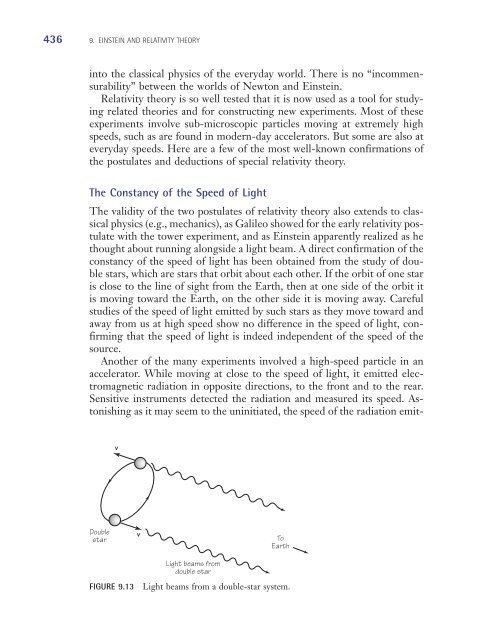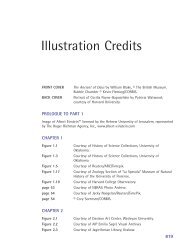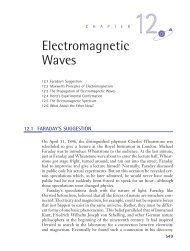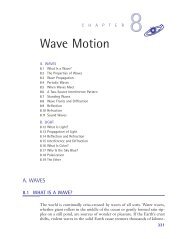Chapter 9: Einstein and Relativity Theory (319 KB) - D Cassidy Books
Chapter 9: Einstein and Relativity Theory (319 KB) - D Cassidy Books
Chapter 9: Einstein and Relativity Theory (319 KB) - D Cassidy Books
Create successful ePaper yourself
Turn your PDF publications into a flip-book with our unique Google optimized e-Paper software.
3637_<strong>Cassidy</strong>TX_09 6/14/02 12:08 PM Page 436<br />
436 9. EINSTEIN AND RELATIVITY THEORY<br />
into the classical physics of the everyday world. There is no “incommensurability”<br />
between the worlds of Newton <strong>and</strong> <strong>Einstein</strong>.<br />
<strong>Relativity</strong> theory is so well tested that it is now used as a tool for studying<br />
related theories <strong>and</strong> for constructing new experiments. Most of these<br />
experiments involve sub-microscopic particles moving at extremely high<br />
speeds, such as are found in modern-day accelerators. But some are also at<br />
everyday speeds. Here are a few of the most well-known confirmations of<br />
the postulates <strong>and</strong> deductions of special relativity theory.<br />
The Constancy of the Speed of Light<br />
The validity of the two postulates of relativity theory also extends to classical<br />
physics (e.g., mechanics), as Galileo showed for the early relativity postulate<br />
with the tower experiment, <strong>and</strong> as <strong>Einstein</strong> apparently realized as he<br />
thought about running alongside a light beam. A direct confirmation of the<br />
constancy of the speed of light has been obtained from the study of double<br />
stars, which are stars that orbit about each other. If the orbit of one star<br />
is close to the line of sight from the Earth, then at one side of the orbit it<br />
is moving toward the Earth, on the other side it is moving away. Careful<br />
studies of the speed of light emitted by such stars as they move toward <strong>and</strong><br />
away from us at high speed show no difference in the speed of light, confirming<br />
that the speed of light is indeed independent of the speed of the<br />
source.<br />
Another of the many experiments involved a high-speed particle in an<br />
accelerator. While moving at close to the speed of light, it emitted electromagnetic<br />
radiation in opposite directions, to the front <strong>and</strong> to the rear.<br />
Sensitive instruments detected the radiation <strong>and</strong> measured its speed. Astonishing<br />
as it may seem to the uninitiated, the speed of the radiation emit-<br />
v<br />
Double<br />
star<br />
v<br />
To<br />
Earth<br />
Light beams from<br />
double star<br />
FIGURE 9.13<br />
Light beams from a double-star system.






